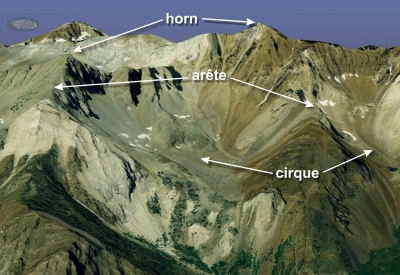WHAT ARE CIRQUES, ARÊTES AND HORNS?

|
Cirques are formed when a glacier wears away a mountainside leaving a rounded hollow with steep, almost vertical, walls. Such basins are usually found at the top of a glacial valley. Arêtes are knife-edged ridges between cirques that are created when glacial erosion occurs on both sides of a mountain. Horns are peaks created when three or more cirques are formed back to back. |
Cirque amphitheatre-shaped basin with precipitous walls, at the head of a glacial valley. It generally results from erosion beneath the bergschrund of a glacier. A bergschrund is a large crevasse that lies a short distance from the exposed rock walls and separates the stationary from the moving ice; in early summer it opens, exposing the rock at its base to diurnal changes of temperature. Frost action then causes rapid disintegration of lower rock, which causes the upper rock to avalanche and produce an almost vertical head wall. Resulting rock material is embedded in the glacier and scours a concave floor, which may contain a small lake (tarn) if the glacier disappears. Expansion of neighbouring cirques produces sharp arêtes, cols, and horns. Because glaciers must originate above the snowline, a survey of the elevations of ancient cirques provides information on climatic change and on the former position of the snow line.
Arête in geology, a sharp-crested serrate ridge separating the heads of opposing valleys (cirques) that formerly were occupied by Alpine glaciers. It has steep sides formed by the collapse of unsupported rock, undercut by continual freezing and thawing. Two opposing glaciers meeting at an arête will carve a low, smooth gap, or col. An arête may culminate in a high triangular peak or horn (such as the Matterhorn) formed by three or more glaciers eroding toward each other.
A glacial horn is a feature created by glaciers and what exactly this term means is intricately linked with how it formed. A horn is a peak that forms from three arêtes. It is also known as a pyramidal peak.
An arête is the edge that forms in the land from cirque erosion, or when two cirque glaciers form up against each other, creating that sharp edge. When more than two arêtes meet, this is a horn.
Credit: Britannica
Picture Credit: Google